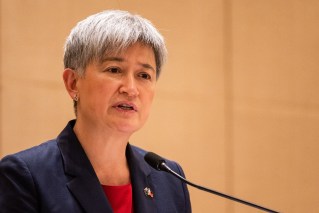‘Things are going to get worse’: Cyber plan unveiled

The federal government's cyber strategy focuses on protecting small and medium businesses. Photo: EPA
Almost $600 million is being put towards erecting six “cyber shields” around Australian infrastructure and businesses to protect them from attacks and to secure networks.
Home Affairs Minister Clare O’Neil on Wednesday unveiled the seven-year cyber strategy.
The layers to protect against cyber attacks include using safe technology, empowering businesses and individuals, protecting critical infrastructure, working with partners in the region and ensuring Australia maintains a sovereign capability.
Combined, they will make it harder for actors to target critical infrastructure and allow the government to bounce back faster when they do slip through.
“We have reason to believe that things are going to get worse and that we are going to face increasing risk,” Ms O’Neil said, launching the policy in Sydney.
“We can’t have a situation where we have data flying around the country, where we have critical infrastructure starting to fail.”
Of the funding, $290 million will go towards supporting small and medium businesses fight cybercrime, while $144 million will help strengthen critical infrastructure and $130 million will boost regional co-operation and capabilities.
There will also be $5 million to create customer standards for smart devices and software to protect consumers.
“The big picture here is making citizens and small business the heart of what we do,” Ms O’Neil said.
This meant targeting the people most vulnerable to attacks or manipulation, including seniors, non-English speakers and people who struggle to find extra support.
More than $26 million will be used to set up cyber assistance teams in the Pacific, while a further $17 million will build resistance and help identify vulnerabilities in the region.
Assistant Foreign Affairs Minister Tim Watts said building cyber defences was an urgent global priority and Australia was “working in tandem with the region to build capacity and long-term resilience to cyber security threats”.
Ms O’Neil said outlawing ransom being paid to cyber criminals would only be done when the time was right, with police not properly resourced and systems not in place to tackle the problem.
“We are in a situation in our country where it is clearly not the right time at this moment to ban ransoms because we haven’t done the hard work,” she said.
The new strategy would help address this and the ransom issue would be revisited after two years.
The Tech Council has backed the strategy, branding it a comprehensive and multi-pronged approach to tackling the increasing threat.
“Improving cyber security is vital to Australia’s economy, our national security and to the lives of Australian citizens,” chief executive Kate Pounder said.
But opposition home affairs spokesman James Paterson criticised the government’s plan as too little, too late.
He called the changes “minor tweaks and logical extensions of the previous government’s policies” after Ms O’Neil promised a complete overhaul.
Most of the elements could have been put in place months ago and the strategy “falls well short of ensuring Australia will become the most cyber-secure country in the world”, he said.
– AAP







